I am pleased to introduce Jeff Howard, The Gameshelf’s first guest blogger.
Jeff is Assistant Professor of Game Development and Design at Dakota State University in Madison, South Dakota. He is the author of Quests: Design, Theory, and History in Games and Narratives. He received his B.A. from the University of Tulsa and his M.A. and Ph.D. from the University of Texas at Austin. He is currently working on a game-in-progress, Arcana Manor, and related research about magic systems.
He plans on writing about games and magic over the next couple of months here, starting with this post. Enjoy! —jmac
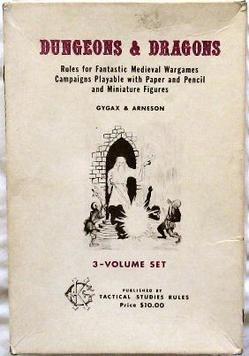
A magic system is any set of symbols and rules designed to rigorously simulate supernatural powers and abilities. Magic is pervasive as a game mechanic and fictional construct within games, spanning across genres (RPG, MMORPG, adventure game, action-adventure, fighter, survival horror) and decades (from the 1974 first edition of Dungeons and Dragons to World of Warcraft and beyond).
Magic is part of the very nature of why people play games: to simulate abilities that they do not possess in real life; to escape from the prison of the mundane to the realm of enchanted; to weave the chaotic forces of life into a rule-bound system that can be understood and, at least partially, controlled.
The problem is that many magic systems aren’t very magical. RPG’s, both multiplayer and single player, have the same shortcoming: players press a button on a tray of icons, then watch an animation fire, followed by a cooldown period, after which players press the same button again. This process of spamming a hotkey button or two, cued to one’s most powerful spells, doesn’t feel like magic.
Magic, as depicted in fantasy literature and occult tradition alike, is a complex and arcane art comprised of gestures and words, as well as ingredients carefully combined with ritualistic artifacts in order to draw away the veil between the natural and supernatural worlds. So, the question emerges: how could designers put the magic back into magic systems?
The solution is a two-pronged approach of game archeology, locating and analyzing the most innovative magic systems in games, and investigating the actual occult systems that can provide inspiration for game designers.
An analysis of magic systems from a game historical perspective is useful in order to locate games which have featured spell-casting methods that are more immersive and richly meaningful than the average RPG. Game interfaces and mechanics tend to become homogenous over time due to familiarity and a desire to create low learning curves for designers and players alike. However, there are many hidden gems from throughout the history of magic systems which occur either before the standard row of spell icons becomes well established or which work in deliberate opposition to this way of casting spells.
While careful examination of game history can help re-energize magic systems from a formal and aesthetic perspective, depth of gameplay may require reaching outside of videogames and into the human ritual practices and metaphysical symbolism often referred to as the occult. In this context, occultism includes many mythological and ritualistic traditions, including Western ceremonial magic as well as tarot and voodoo, characterized by an attempt to conjure and control metaphysical forces. Game designers have tended to shy away from talking about the metaphysical aspect of magic systems because of the attack on Dungeons and Dragons in the 1980’s by fundamentalist Christian groups due to its perceived occult content or ritualistic nature. Yet, because rituals are intended to be practiced rather than merely observed or read about, ceremonial tradition is often systematically organized in a way that lends itself to being implemented digitally and interactively.
As both historical examples and cases of confluence between gaming and metaphysical magic systems, there have been many innovative games featuring magical grammars, usually in the form of runes or symbols that can be combined to create spells. The word grimoire comes from the Middle English grammarye, which means grammar, as in a set of syntactical rules for combining words into well-formed sentences. A grammar can also refer to a book containing these linguistic rules. The etymological connection between grimoire and grammar comes from a medieval distrust of learning whereby any schoolmaster carrying a grammatical handbook was perceived by the illiterate as a potential warlock. At the same time, grimoires resemble grammars because grimoires contain the meaning of elaborate symbols and sigils as well as rules for combining these symbols in order to produce magical effects through ritual.
Rituals are complex multi-sensory productions involving the rule-based combination of gestures (tracing sigils), objects (wands and chalices), spatial configurations (temples and magic circles), auditory elements (chanting and music), and scents (incense). Such symbols are combined according to the principle of correspondences, by which elements stand by association for other elements. The literature of ceremonial magic is rife with tables of corresponding Tarot cards, Hebrew letters, astrological signs, musical notes, precious gems, and innumerable other elements. Such books include Aleister Crowley’s Liber 777 and its more recent expansion as Stephen Skinner’s Complete Magician’s Tables. The correspondences tabulated within these books are regarded by practitioners as deeply meaningful and intended to encode insights about the metaphysical structure of the universe (often by way of the kabbalistic tree of life, whose branches or sephiroth have lent their name to one famous RPG villain).
Magicians express meaning in ritual through performative and participatory action, requiring the active involvement of magical practitioners with an understanding of its rules and symbol systems. As such, ceremonial magic is a precursor and analogue to games as interactive multimedia. Because these multimedia performances are intended to accomplish pragmatic or spiritual work, ritual in ceremonial magic is often referred to as a working or, in more modern English, an operation. Both these words were frequently used by occultist Aleister Crowley and, later, by graphic novelist Alan Moore to refer to his spiritually-purposed multimedia performances. The words working and operation also hearken to the tradition of opera (Italian for work), so named because the synergy of music, poetry, theatrical sets, and costuming is a work of art that is greater than the sum of its parts. The most superb magic systems and the games of which they are a part aspire toward the condition of opera, as in the magnificent cohesion of Demon’s Souls. Indeed, scholars such as Marie-Laure Ryan regard Richard Wagner’s imagined synaesthetic and fourth-wall-shattering future opera, called gesamundwerkt (German for “total art work”), as a foreshadowing of interactive multimedia.
Unfortunately, games rarely take full advantage of this potential for multimedia input or feedback, instead restricting players to mouse or gamepad input accompanied by primarily auditory and visual feedback with a minor amount of haptics. However, the increasing prevalence of alternative input methods like the Wiimote and the upcoming Kinect affords multiple opportunities for multimodal input that more closely simulate magic as a subtle art of multimodal ritual. Moreover, the history of magic systems offers multiple examples of games that allow players to cast spells using combinatorial grammars, alternative input methods, and sometimes a combination of grammar and alternative control scheme. By studying and understanding magic systems with these traits, designers and students of game design can imitate and improve upon their best features within new technological contexts.
In terms of combinatorial grammars with metaphysically meaningful correspondences, the highest example may be Eternal Darkness: Sanity’s Requiem, a horror game in which players cast spells by placing runes along the points of geometric figures in order to express a given spell’s meaning. For example, the combination of “protect,” “self,” and “intensify” would create a buffing magical armor spell at a level of power influenced by the number of intensification runes (“pargon”) placed at the end of the spell. Moreover, players cast each spell under the aspect of three alignment runes that correspond to Lovecraftian Ancients, each of which is in turn associated with a color that stands for a principle of humanity (body, mind, and sanity). These three Ancients and their associated runes and colors trump each other in a rock-paper-scissors mechanic at the game’s heart, which players manipulate by imbuing weapons and protective spells with a particular color of magic designed to overcome monsters of the opposed (and weaker) color. Spells in Eternal Darkness are philosophical propositions with narrative context and magical force: for example, X’elatoth’s green rune trumps Chatturgah’s red rune because the dissolution of sanity erodes the body, an outcome that can be enacted mythologically in the winning ending of a play-through in which the enemy boss aligns himself with X’elatoth.
This particular lineage of games with combinatorial grammars, of which Eternal Darkness is a high point, starts with an early first-person dungeon crawling RPG Dungeon Master, in which players combined strings of runes in order to cast spells. These runes allow for the discovery of new spells through trial-and-error experimentation, enacted in real-time combat that adds both a cerebral and a dexterity-based challenge to the system. Despite these technical innovations, Dungeon Master lacked an overarching meaning to its systems beyond flavor text within the game’s manual.
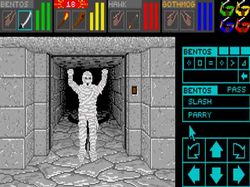 Ultima Underworld I and Ultima Underworld II extend the lineage of Dungeon Master, in which players collect rune stones in order to piece together, through trial and error, spells governed by a magical grammar. This magic system has precedents in the virtue system of Britannia, based on a set of correspondences between three principles of Truth, Love, and Courage and their combinations to form eight virtues, each of was attributed to a dungeon, a town, a character class, and a color based on permutations of three primary tints. The magic system of the early Ultima games was, to a limited extent, based on runes and syllables typed in a text parser, as well as the combination of alchemical reagents. However, Ultima Underworld added a grammatically based combinatorial system as well as a first-person interface hearkening back to Dungeon Master. The occurrence of first-person interfaces with grammatically-based magic systems suggests that both features serve the larger goal of immersion—allowing the player to actively take the role of spell-caster through the mechanic of combining magic words and the visual perspective from the eyes of the caster.
Ultima Underworld I and Ultima Underworld II extend the lineage of Dungeon Master, in which players collect rune stones in order to piece together, through trial and error, spells governed by a magical grammar. This magic system has precedents in the virtue system of Britannia, based on a set of correspondences between three principles of Truth, Love, and Courage and their combinations to form eight virtues, each of was attributed to a dungeon, a town, a character class, and a color based on permutations of three primary tints. The magic system of the early Ultima games was, to a limited extent, based on runes and syllables typed in a text parser, as well as the combination of alchemical reagents. However, Ultima Underworld added a grammatically based combinatorial system as well as a first-person interface hearkening back to Dungeon Master. The occurrence of first-person interfaces with grammatically-based magic systems suggests that both features serve the larger goal of immersion—allowing the player to actively take the role of spell-caster through the mechanic of combining magic words and the visual perspective from the eyes of the caster.
These twin features of magical grammar and first-person interface gain the third element of a gestural interface to form a triad of immersive magic-casting in Arx Fatalis, a dungeon crawl by Arkane studios originally pitched as the third Ultima Underworld, in which players cast spells by tracing combinations of runes in the air with colored light.
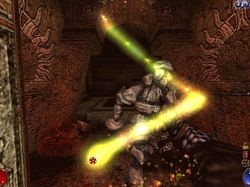
(This method of spell-casting resembles and may originate within certain occultist traditions, such as the Lesser Ritual of the Pentagram of the Order of the Golden Dawn, in which ceremonial magicians traced combinations of pentagrams in various configurations and with appropriate implements in order to banish or invoke spiritual presences.)
A more immersive but less combinatorial approach appears in Black and White, Peter Molyneux’s famed strategy game, which deliberately eliminates a heads-up display or HUD in order to allow players godlike control over a disembodied hand that traces symbols over its domain in order to cast miracles. Molyneux’s game is sometimes referred to as the first gestural interface, in part because a later patch enabled players to control gestures with a P5 Virtual Reality glove, adding another level of physical immersion.
Next week’s installment of this blog series will discuss gestural magic systems and other related forms of controlling spells through multimodal input, including some discussion of a game I am currently developing to put these ideas into practice.

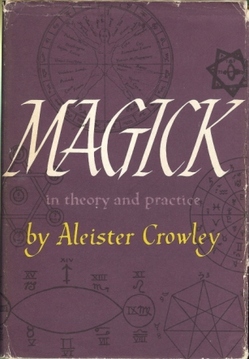
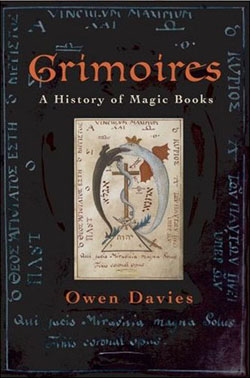
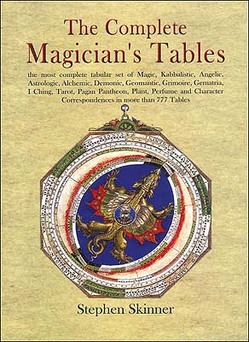
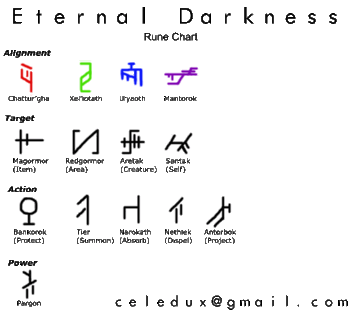
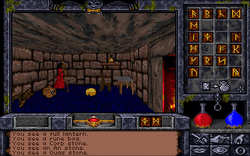

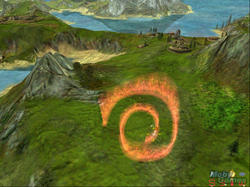

Thorough and intriguing as always, Jeff. Here's an odd idea: do you think the Konami Code popularized by Contra on the NES constitutes a gestural magic interface? The player had to ritualistically input UUDDLRLRBA to be granted a boon of 30 lives... sort of a meta-magic spell :)
This is a very insightful article, Jeff.
Josh brought this to my attention when I told him I was working on a fast-paced dungeon crawler that using the mouse for offense and defense. In particular I noted drawing patterns with the mouse for attacks, like trying to draw a spell glyph under pressure. Faster enemies would offer you less time to draw the glyph, and tougher enemies would need stronger spells to penetrate their armor.
One game I had thought of was Lost Magic for the Nintendo DS where you used the stylus to draw up to 3 runes out of 18. It also had a rudimentary RTS where you summoned and controlled monsters, although I think there was too much overkill at that point.
At any rate, I wait patiently for your next article.
Nitpick: You've actually got the runes in Eternal Darkness backwards. If the villain chooses Xel'otath, the player winds up beating him with Chattur'gha. Xel'otath trumps Ulyaoth, with insanity eroding the mind.